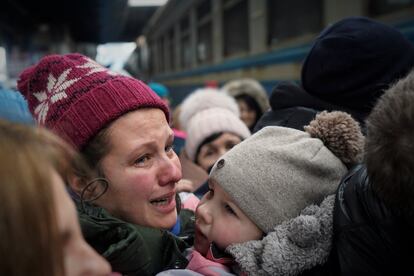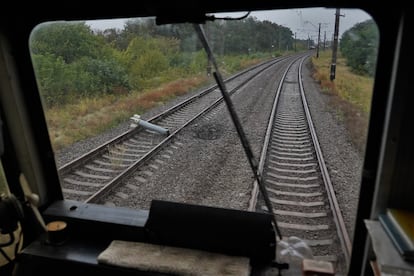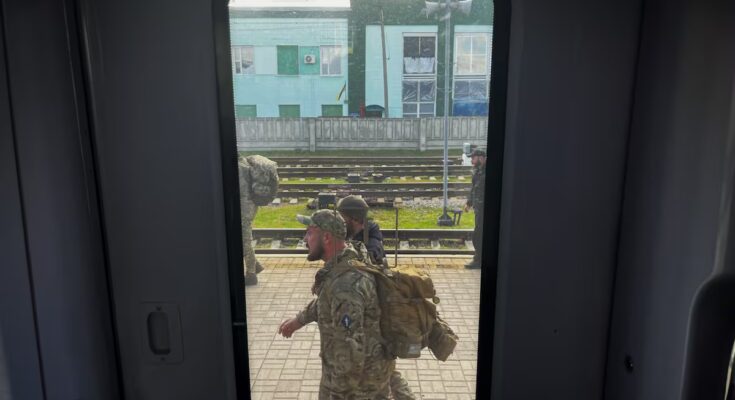Ukraine has announced the suspension of the railway line that connects the eastern region of Donbas, almost entirely under Russian rule and where the main war front is located, with the rest of the country. Trains surprisingly arrive every day at Sloviansk and Kramatorsk stations, under constant siege by the enemy. Throughout the course of the war, the railway infrastructure was, on the one hand, a permanent objective and, on the other, one of the symbols of resistance and local pride against the Russian invasion. The pressure of Moscow’s troops in recent days has kept the city of Pokrovsk almost surrounded. Something similar may soon happen with Konstiantinivka, which itself borders Kramatorsk and Sloviansk, closing the main line of resistance against the invader in the east. Hence the importance of the decision to close that line.
Attacks against convoys, stations and electrical substations number in the hundreds. But the increase in the offensive in recent months, especially with drones, forced the national company Ukrzaliznytsia to announce on Wednesday afternoon that, due to imposition of the regional military authority and for security reasons, that route will have to temporarily suspend the exercise. Five long-distance railways passed through it every day, according to the press release made public. “The safety of passengers is our top priority. We are carefully monitoring the situation and will resume traffic as soon as possible”, adds the company, which has already lost almost a thousand workers under the bombs.
Already in recent days, as one of the special correspondents of EL PAÍS verified, the convoys traveling from Kiev and other areas further west were unable to reach either of the two stations mentioned above. These stopped at the small rural station of Husarivka (Kharkov region), from where the passengers, mostly military personnel, completed the rest of the journey by minibus. The same thing happened to travel the route in reverse. From now on they will only arrive at Husarivka or Barvinkove stations, both in Kharkiv. A week ago, Russian attacks hit the railway infrastructure of Lozova (Kharkov), an important logistics and communications hub near Husarivka, and the Sumi passenger station.

Kramatorsk station, the terminus of the now suspended trains, is crucial not only for the movement of troops. It is also the case for military supplies of all kinds, including ammunition and weapons with which Ukraine seeks to defend the Donbas, made up of the regions of Donetsk, 30% controlled by Kiev, and Lugansk, almost entirely under the control of Moscow. Both, together with the Crimean peninsula, are the basis of Putin’s expansionist aims in Ukraine. Therefore, the cancellation of trains to Sloviansk and Kramatorsk will be seen as a new victory for the Kremlin.
Surviving in the midst of war is not free for the railway company. It continues to subsidize passenger transport despite losses that exceeded 18 billion hryvnia (about 372 million euros) in 2024 and are expected to exceed 22 billion hryvnia (455 million euros) in 2025, according to data published by local media. On Tuesday the government announced an injection of 13,000 million hryvnia (about 269 million euros) to support Ukrzaliznytsia in 2025.
The transportation of the Donbas coal mines was an important source of income which now, with the closure of the last mine, Bilozerska, has ended up sinking. Since the outbreak of the great Russian invasion, the company has lost 49% of its cargo traffic, according to data presented this week in Parliament by the company’s vice president, Serhiy Leschenko, who foresees a shock plan in 2026 with a 41.5% increase in fares.
In turn, Zelensky announced on November 1 a program that will allow Ukrainians to travel up to 3,000 kilometers for free starting in December and during the four-month low season. This is a way to enhance the service by occupying free spaces and completing less busy lines and times.
The worst attack against civilians
Kramatorsk station was already making headlines as the scene of the largest attack on civilians by Kremlin troops during the current conflict, with nearly 60 people killed. Two missiles hit the facilities on April 8, 2022, as hundreds of people, most of them women and children, were being evacuated aboard trains to take them away from the front lines. On the fuselage of one of the shells was written in Russian: “For children.”
A few meters from where a memorial commemorates those victims, the trains were the target of Russian drones until a few days ago. The last time one of these bombs hit a convoy at these facilities was on October 24, when the train from Lviv arrived in Kramatorsk. The explosion left no injuries, but caused minor damage to three carriages. It was a warning of the prevailing insecurity a few days after the definitive suspension of communications.
Ukrzaliznytsia, the country’s largest employer with more than 230,000 workers, is the main target of Russian attacks. Indeed, according to the company’s calculations, up to 948 employees died during the large-scale invasion launched by the government led by President Vladimir Putin starting in February 2022.

One of the objectives of the company’s management in recent years has been to overcome these attacks as quickly as possible. To this end they try to carry out the necessary repairs almost on the fly, they try to keep as many lines open as possible and, despite the enormous difficulties, they try to ensure that the trains arrive with a level of punctuality unbecoming for a country at war.
From the same morning of February 24, 2022, with Russian tanks advancing towards Kyiv or Kharkiv, the two main cities of the country, thousands of people began to crowd into different stations, such as that of the capital. There, without needing to buy a ticket, travelers filled the carriages that immediately set off towards the west of the country. Ukrzaliznytsia, in fact, was the main means of transport used by millions of Ukrainians to take refuge abroad or to seek accommodation in areas far from the armed conflict.
Furthermore, a few weeks after the start of the great invasion, the company launched the program known as Iron Diplomacy. The goal was to keep the country connected to the outside world and to ensure that as many leaders, authorities, personalities and businessmen could travel safely through a territory where airspace for civilian flights was – and continues to be – closed. Dozens of presidents and prime ministers have done so in this period, from Pedro Sánchez and most European leaders to the American Joe Biden. The local president himself, Volodymyr Zelenskyj, often travels by train. No accidents were reported during these VIP trips, which served to increase the company’s reputation.
But the Russian advance forced the cancellation of Ukrzaliznytsia’s activity in several locations in the east of the country before Kramatorsk and Sloviansk. This is what happened in recent months in Konstiantinivka or Pokrovsk, today a city almost in ruins. In the latter, the structures of the passenger station are currently the scene of intense fighting between local and Russian troops. Two years ago, when Pokrovsk was a rearguard, its tracks hosted the medical train that Ukrzaliznytsia had chartered together with Doctors Without Borders (MSF) to evacuate wounded civilians. Today, of the 60,000 inhabitants, just a thousand remain in a city practically surrounded by Russians.



